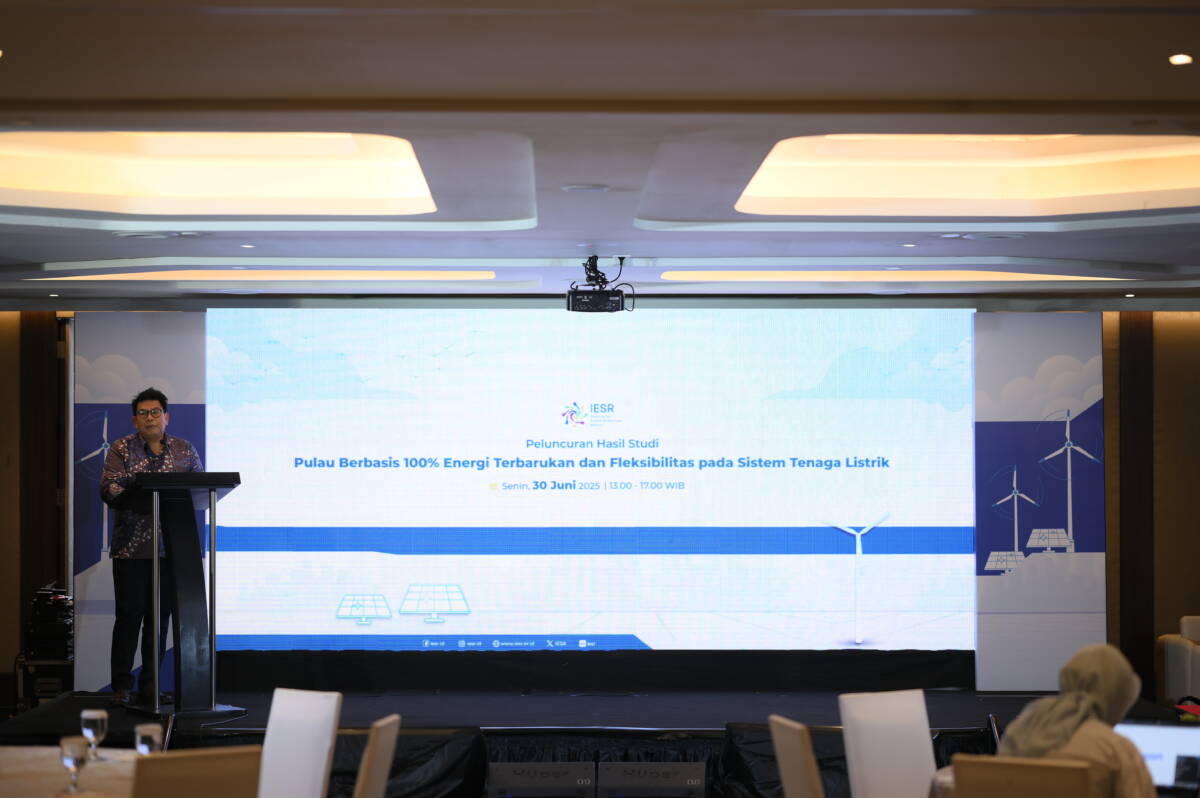Jakarta, June 30, 2025 – As the world’s largest archipelago, Indonesia has an advantage in accelerating the energy transition. The Institute for Essential Services Reform (IESR) believes that the development of independent distributed energy systems on each island can strengthen energy security and support the achievement of the national net zero emission (NZE) target of 2060 or sooner. Supported by a tropical climate, Indonesia also has an even supply of renewable energy, especially from solar power.
IESR considers that the development of renewable energy on each island is not only a geographical necessity, but also economically beneficial. IESR’s latest study shows that Timor, Sumbawa, and Sulawesi islands can fulfill 100 percent of their electricity needs from renewable energy. The investment needed to realize Timor Island and Sumbawa Island reaches USD 5.21 billion or around Rp85 trillion until 2050.
Executive Director of IESR, Fabby Tumiwa at the launch of the study results “100% Renewable Energy-Based Island and Flexibility in the Electric Power System” on Monday (30/5/2025), in Jakarta, emphasized that the development of island-based renewable energy is a strategic step. Some of the reasons include cost efficiency compared to the construction of submarine transmission networks which can be three to five times more expensive than land cables, reaching USD 2-3 million per kilometer. Not only that, the utilization of renewable energy on islands is also able to reduce logistical risks and energy crises due to dependence on fuel shipments to remote islands.
“Through this study, we found that in Sulawesi, the flexibility of the electricity system is key to integrating variable renewable energy sources as the industry develops there. Meanwhile, utilizing 100 percent renewable energy on Sumbawa Island could serve as a model for other island nations to achieve energy independence while contributing to global climate goals. In addition, on Timor Island, the development of solar, wind and biomass energy can replace fossil energy plants, including those planned in the latest General Plan for Electricity Supply (RUPTL), with more competitive electricity prices,” Fabby explained.
Abraham Halim, IESR’s Electricity System Analyst, explained that Sulawesi has the potential for financially viable renewable energy projects of around 63 GW, especially solar and wind energy. According to IESR’s modeling based on the National Electricity General Plan (RUKN), variable renewable energy (VRE) such as solar and wind energy in Sulawesi will increase from 2.4 percent in 2024 to 29 percent in 2060.
IESR’s analysis shows that Sulawesi’s electricity system in the short term (2030-2040) will rely on flexibility of generation, both from other renewables such as hydro, fossil, and new energy. In the long term, flexibility will rely on batteries for daily scale, interconnection with other islands for weekly scale, and seasonal management.
To support energy system flexibility in Sulawesi, IESR recommends that the government integrate flexibility analysis in long-term planning and operational forecasts by considering needs across all time scales and appropriate solutions. In addition, optimizing bioenergy potential, as well as a combination of variable renewable energy and energy storage along with strengthening interconnection as an effort to lower overall system costs.
Alvin P Sisdwinugraha, Electricity and Renewable Energy Analyst, IESR said that the main asset of Sumbawa Island in West Nusa Tenggara (NTB) and Timor Island in East Nusa Tenggara (NTT) lies in the strong ambition of local governments. NTB aims to achieve NZE by 2050, while NTT sets a renewable energy mix target of 47 percent by 2034, as stated in the latest draft of the Regional Energy General Plan (RUED).
Sumbawa Island has a total renewable energy potential of 10.21 GW, with the largest potential being solar energy (8.64 GW). To meet Sumbawa Island’s energy needs with 100 percent renewable energy, IESR encourages the implementation of the following two strategies: a short-term strategy (2025-2035) by replacing fossil fuel power plant projects under planning with renewable energy-based power plants, and a long-term strategy (2036-2050) with the main focus on gradually reducing fossil power plants with a fuel replacement strategy to hydrogen and green ammonia.
Meanwhile, Timor Island has 30.81 GW of energy potential, with solar energy having the largest potential (20.72 GW). Timor Island can also achieve 100 percent renewable energy by 2050. The short-term strategy (2025-2035) is to replace PLTU and PLTG projects in the planning with renewable energy generation. The process of intervening in the RUPTL needs to be thorough and transparent to stay within the law and improve the renewable energy procurement process.
Long-term strategy (2036-2050) total phase-out of fossil generation by 2050, including early retirement of Timorese power plants as the most economical option. The main replacement is large-scale solar PV with power storage. By 2050, Timor’s system will generate electricity from solar energy (82%), mini hydro (9%), wind (6%) and biomass (3%).
The study recommends a number of steps to realize an island with 100 percent renewable energy. First, accelerate the energy transition by preparing a financing mechanism and legal framework to accelerate the early retirement of coal-fired power plants. Second, increase the flexibility of the electricity system by allowing more flexible operation of coal-fired power plants and investing in the development of long-duration energy storage technologies. Third, support the development of energy storage technologies and grid infrastructure to accommodate higher penetration of renewable energy. Fourth, reform energy planning and procurement processes, including by simplifying renewable energy procurement processes, integrating green hydrogen roadmaps into regional energy planning, and encouraging the implementation of pilot projects.
“This transformation requires coordination among various stakeholders. Government agencies must harmonize policies across sectors, energy providers need to collaborate on regional planning and resource sharing, while private sector participation must be encouraged through a clear and stable investment framework,” Alvin said.

